Urban River Health Analysis of the Jialu River in Zhengzhou City Using the Improved Fuzzy Matter-Element Extension Model
Abstract
:1. Introduction
2. Materials and Methods
2.1. Study Region
2.2. Index System
2.3. Data Sources
2.4. Improved Fuzzy Matter-Element Extension Model
- Normalization of the index value. Given the differences in the scope of the selected indexes, the raw data of the indexes needed to be normalized before analyzing the indexes, in the following way:where represents the evaluation index, ; refers to the evaluation year, ; and represent the number of indicators and the number of years surveyed, respectively; is the initial value of the index in -th year; and is the normalized value of .
- Calculation of the information entropy of the index.where is the information entropy of the index .
- Calculation of the entropy weight of the index.where is the entropy weight of the index .
3. Results and Discussion
3.1. Results
3.1.1. Entropy Weight
3.1.2. Results of the Fuzzy Matter-Element Extension Model
3.2. Comprehensive Evaluation of the Jialu River’s Health
3.3. Assessment of Different Subsystems
3.3.1. Assessment of the Pressure Subsystem
3.3.2. Assessment of the State Subsystem
3.3.3. Assessment of the Response Subsystem
4. Conclusions
Author Contributions
Funding
Conflicts of Interest
References
- Jia, Y.T.; Chen, Y.F. River health assessment in a large river: Bioindicators of fish population. Ecol. Indic. 2013, 26, 24–32. [Google Scholar] [CrossRef]
- Luo, Z.L.; Zuo, Q.T.; Shao, Q.X. A new framework for assessing river ecosystem health with consideration of human service demand. Sci. Total Environ. 2018, 640, 442–453. [Google Scholar] [CrossRef] [PubMed]
- Pan, G.; Xu, Y.; Yu, Z. Analysis of river health variation under the background of urbanization based on entropy weight and matter-element model: A case study in Huzhou City in the Yangtze River Delta, China. Environ. Res. 2015, 139, 31–35. [Google Scholar] [CrossRef] [PubMed]
- Zhai, X.; Zhang, Y.; Wang, X.; Xia, J.; Liang, T. Non-point source pollution modelling using Soil and Water Assessment Tool and its parameter sensitivity analysis in Xin’anjiang catchment, China. Hydrol. Process. 2014, 28, 1627–1640. [Google Scholar] [CrossRef]
- Song, Q.H.; Yang, Z.F. Thinking of integrated management of urban rivers in China. Adv. Water Sci. 2002, 13, 377–382. [Google Scholar]
- Xu, W.; Dong, Z.C.; Hao, Z.C.; Li, D.Y. River health evaluation based on the Fuzzy matter-element extension assessment model. Pol. J. Environ. Study 2017, 26, 1353–1361. [Google Scholar] [CrossRef]
- Scrimgeour, G.J.; Wicklum, D. Aquatic Ecosystem Health and Integrity: Problems and Potential Solutions. J. N. Am. Benthol. Soc. 1996, 15, 8. [Google Scholar] [CrossRef]
- Smith, M.J.; Kay, W.R.; Edward, D.H.D. AusRivAS: Using macroinvertebrates to assess ecological condition of rivers in Western Australia. Freshw. Biol. 2010, 41, 269–282. [Google Scholar] [CrossRef]
- Sylvain, D.; Statzner, B. Invertebrate traits for the biomonitoring of large European rivers: An assessment of specific types of human impact. Freshw. Biol. 2008, 53, 617–634. [Google Scholar]
- Schofield, N.J.; Davies, P.E. Measuring the health of our rivers. Water 1996, 5, 39–43. [Google Scholar]
- Petesse, M.L.; Siqueira-Souza, F.K.; Freitas, C. Selection of reference lakes and adaptation of a fish multimetric index of biotic integrity to six amazon floodplain lakes. Ecol. Eng. 2016, 97, 535–544. [Google Scholar] [CrossRef]
- Hering, D.; Feld, C.K.; Moog, O. Cook book for the development of a Multimetric Index for biological condition of aquatic ecosystems: Experiences from the European AQEM and STAR projects and related initiatives. Hydrobiologia 2006, 566, 311–324. [Google Scholar] [CrossRef]
- Deng, X.J.; Xu, Y.P.; Zhai, L.X.; Liu, Y.; Li, Y. Establishment and application of the index system for urban river health assessment. Acta Ecol. Sin. 2014, 34, 993–1001. [Google Scholar]
- Chen, K.; Chen, Q.W.; Yu, H.Y. Methods and prospects of index of biological integrity used for China river ecological health assessment. China Environ. Sci. 2018, 8, 1589–1600. [Google Scholar]
- Ladson, A.R. Development and testing of an Index of Stream Condition for waterway management in Australia. Freshw. Biol. 1999, 41, 453–468. [Google Scholar] [CrossRef]
- Dean, J.; Charles, B.; Helen, F. Preliminary testing of the Integrated Habitat Assessment System (IHAS) for aquatic macroinvertebrates. J. Limnol. Soc. S. Afr. 2006, 31, 14. [Google Scholar]
- Growns, I.; Rourke, M.; Gilligan, D. Toward river health assessment using species distributional modeling. Ecol. Indic. 2013, 29, 138–144. [Google Scholar] [CrossRef]
- Guan, B.; An, S.; Gu, B. Assessment of ecosystem health during the past 40 years for Lake Taihu in the Yangtze River Delta, China. Limnology 2011, 12, 47–53. [Google Scholar] [CrossRef]
- Xu, Z.H.; Xu, Y.P.; Zhang, Y.; Deng, X.J. Assessment of river health in urbanized area based on entropy weight and matter element model: A case study in Huzhou city at different stages of urbanization. Acta Sci. Circumstantiae 2014, 34, 3188–3193. [Google Scholar]
- Wu, Z.X.; Kong, M.; Cai, Y.J.; Wang, X.L.; Li, K.Y. Index of biotic integrity based on phytoplankton and water quality index: Do they have a similar pattern on water quality assessment? A study of rivers in Lake Taihu Basin, China. Sci. Total Environ. 2019, 658, 395–404. [Google Scholar] [CrossRef]
- Liu, Q.; Dong, Z.; Xu, W.; Fu, X.; Tan, J.; Chen, X.; Yang, G. Health Assessment of Luanhe River Based on Fuzzy Matter-element Model. Water Resour. Power 2014, 32, 47–55. [Google Scholar]
- Deng, X.J.; Xu, Y.P.; Han, L.F.; Yu, Z.H.; Yang, M.N.; Pan, G.B. Assessment of river health based on an improved entropy-based fuzzy matter-element model in the Taihu Plain, China. Ecol. Indic. 2015, 57, 85–95. [Google Scholar] [CrossRef]
- Chen, W.; Li, W.P.; Chai, H.C.; Hou, E.K.; Li, X.Q.; Ding, X. GIS-based landslide susceptibility mapping using analytical hierarchy process (AHP) and certainty factor (CF) models for the Baozhong region of Baoji City, China. Environ. Earth Sci. 2016, 75, 14. [Google Scholar] [CrossRef]
- Xie, J.X.; Cheng, C.T.; Chau, K.W.; Pei, Y.Z. A hybrid adaptive time-delay neural network model for multi-step-ahead prediction of sunspot activity. Int. J. Environ. Pollut. 2006, 28, 364–381. [Google Scholar] [CrossRef]
- Tchórzewska-Cieślak, B. Bayesian model of urban water safety management. Glob. Nest J. 2014, 16, 667–675. [Google Scholar]
- Liu, D.J.; Zou, Z.H. Water quality evaluation based on improved fuzzy matter-element method. J. Environ. Sci. 2012, 24, 1210–1216. [Google Scholar] [CrossRef]
- Zhao, Y.W.; Yang, Z.F. Integrative fuzzy hierarchical model for river health assessment: A case study of Yong River in Ningbo City, China. Commun. Nonlinear Sci. Numer. Simul. 2009, 14, 1729–1736. [Google Scholar] [CrossRef]
- Valis, D.; Zak, L.; Walek, A. Selected mathematical functions used for operation data information. In Safety, Reliability and Risk Analysis: Beyond the Horizon; CRC Press-Taylor & Francis Group: Boca Raton, FL, USA, 2014; pp. 1303–1308. [Google Scholar]
- Yang, D.; Mak, C.M. An assessment model of classroom acoustical environment based on fuzzy comprehensive evaluation method. Appl. Acoust. 2017, 127, 292–296. [Google Scholar] [CrossRef]
- Cai, W.; Guo, K.; Huang, Y. Matter element analysis and value engineering. J. Guangdong Univ. Technol. 1984, 1, 7–12. [Google Scholar]
- Wang, Q.; Li, S.Q.; He, G. Evaluating water resource sustainability in Beijing, China: Combining PSR model and matter-element extension method. J. Clean. Prod. 2019, 206, 171–179. [Google Scholar] [CrossRef]
- Huang, B.; Wei, N.; Meng, W. Marine biodiversity evaluation based on the pressure-state-response (PSR) model of Changhai County, Liaoning Province. Biodivers. Sci. 2016, 24, 48–54. [Google Scholar] [CrossRef]
- Wang, Q.; Li, S.Q.; He, G. Evaluating sustainability of water-energy-food (WEF) nexus using an improved matter-element extension model: A case study of China. J. Clean. Prod. 2018, 202, 1097–1106. [Google Scholar] [CrossRef]
- Wolfslehner, B.; Vacik, H. Evaluating sustainable forest management strategies with the Analytic Network Process in a Pressure-State-Response framework. J. Environ. Manag. 2008, 88, 1–10. [Google Scholar] [CrossRef] [PubMed]
- Zhao, Y.W.; Zhou, L.Q.; Dong, B.Q. Dai Health assessment for urban rivers based on the pressure, state and response framework—A case study of the Shiwuli River. Ecol. Indic. 2019, 99, 324–331. [Google Scholar] [CrossRef]
- Liu, N.N.; Liu, C.Z.; Xia, Y.Y.; Da, B.W. Examining the coordination between urbanization and eco-environment using coupling and spatial analyses: A case study in China. Ecol. Indic. 2018, 93, 1163–1175. [Google Scholar] [CrossRef]
- Feng, Z.; Zhang, J.; Wu, R.; Ma, Q.; Yang, J. Ecosystem health assessment based on DPSIRM framework and health distance model in Nansi Lake, China. Stoch. Environ. Res. Risk Assess. 2016, 30, 1235–1247. [Google Scholar]
- Xia, T.; Zhu, W.; Xin, P.; Li, L. Assessment of urban stream morphology: An integrated index and modelling system. Environ. Monit. Assess. 2010, 167, 447–460. [Google Scholar] [CrossRef]
- Liang, K.M.; Zhang, J.E.; Zhao, B.L.; Ye, Y.Q.; Kong, X.H. Review on the Application and Research of Ecological Riverbanks for Water Systems. Trop. Geogr. 2014, 89, 280–283. [Google Scholar]
- Singh, P.K.; Saxena, S. Towards developing a river health index. Ecol. Indic. 2018, 85, 999–1011. [Google Scholar] [CrossRef]
- Pinto, U.; Maheshwari, B. A framework for assessing river health in peri-urban landscapes. Ecohydrol. Hydrobiol. 2014, 14, 121–131. [Google Scholar] [CrossRef]
- Smith, M.W.; Bracken, L.J.; Cox, N.J. Toward a dynamic representation of hydrological connectivity at the hillslope scale in semiarid areas. Water Resour. Res. 2010, 46. [Google Scholar] [CrossRef] [Green Version]
- Wang, T.; Liu, S.; Qian, X.; Shimizu, T.; Dente, S.M.; Hashimoto, S.; Nakajima, J. Assessment of the municipal water cycle in China. Sci. Total Environ. 2017, 607, 761–770. [Google Scholar] [CrossRef] [PubMed]
- Zhang, S.; Fan, W.; Yi, Y.; Zhao, Y.; Liu, J. Evaluation method for regional water cycle health based on nature-society water cycle theory. J. Hydrol. 2017, 551, 352–364. [Google Scholar] [CrossRef]
- Dong, G.H.; Shen, J.Q.; Jia, Y.Z.; Sun, F.H. Comprehensive Evaluation of Water Resource Security: Case Study from Luoyang City, China. Water 2018, 10, 1106. [Google Scholar] [CrossRef]
- Amores, M.J.; Meneses, M.; Pasqualino, J. Environmental assessment of urban water cycle on Mediterranean conditions by LCA approach. J. Clean. Prod. 2013, 43, 84–92. [Google Scholar] [CrossRef]
- State Environmental Protection Administration. Environmental Quality Standards for Surface Water (GB3838-2002); State Environmental Protection Administration: Beijing, China, 2002.
- Water Resources Department of Henan Province. Henan Water Resources Bulletin (2008–2017); Water Resources Department of Henan Province: Zhengzhou, China, 2017.
- Cai, W. Extension theory and its application. Chin. Sci. Bull. 1999, 44, 1538–1548. [Google Scholar] [CrossRef]
- Liu, B.; Sun, F.H. Research on the Risk Assessment Method of PPP Project based on the Improved Matter Element Model. Sci. Iran. 2019, 39, 98–110. [Google Scholar] [CrossRef]
- Han, H.; Li, H.M.; Zhang, K.Z. Urban water ecosystem health evaluation based on the improved fuzzy matter-element extension assessment model: Case study from Zhengzhou City, China. Math. Probl. Eng. 2019, 2019, 1–14. [Google Scholar] [CrossRef]
- Xu, L.; Shen, J.; Marinova, D.; Gao, X.; Sun, F. Changes of public environmental awareness in response to the Taihu blue-green algae bloom incident in China. Environ. Dev. Sustain. 2013, 15, 1281–1302. [Google Scholar] [CrossRef]
- Lirn; Thanopoulou, H.A.; Beynon, M.J.; Beresford, A.K.C. An application of AHP on transhipment port selection: A global perspective. Marit. Econ. Logist. 2004, 6, 70–91. [Google Scholar] [CrossRef]
- Zou, Z.H.; Yun, Y.; Sun, J.N. Entropy method for determination of weight of evaluating indicators in fuzzy synthetic evaluation for water quality assessment. J. Environ. Sci. 2006, 18, 1020–1023. [Google Scholar] [CrossRef]
- Xie, T.; Wang, M.; Su, C.; Chen, W. Evaluation of the natural attenuation capacity of urban residential soils with ecosystem-service performance index (EPX) and entropy-weight methods. Environ. Pollut. 2018, 238, 222–229. [Google Scholar] [CrossRef]
- Qiu, Y.H. Management Decision Entropy and its Application; China Electric Power Press: Beijing, China, 2011. [Google Scholar]
- Han, B.L.; Liu, H.X.; Wang, R.S. Urban ecological security assessment for cities in the Beijing-Tianjin-Hebei metropolitan region based on fuzzy and entropy methods. Ecol. Model. 2015, 318, 217–225. [Google Scholar] [CrossRef]
- Delgado, A.; Romero, I. Environmental conflict analysis using an integrated grey clustering and entropy-weight method: A case study of a mining project in Peru. Environ. Model. Softw. 2016, 77, 108–121. [Google Scholar] [CrossRef]
- Li, B.; Yang, G.S.; Wang, R.R.; Hörmann, G. Dynamic water quality evaluation based on fuzzy matter-element model and functional data analysis, a case study in Poyang Lake. Environ. Sci. Pollut. Res. 2017, 24, 19138–19148. [Google Scholar] [CrossRef]
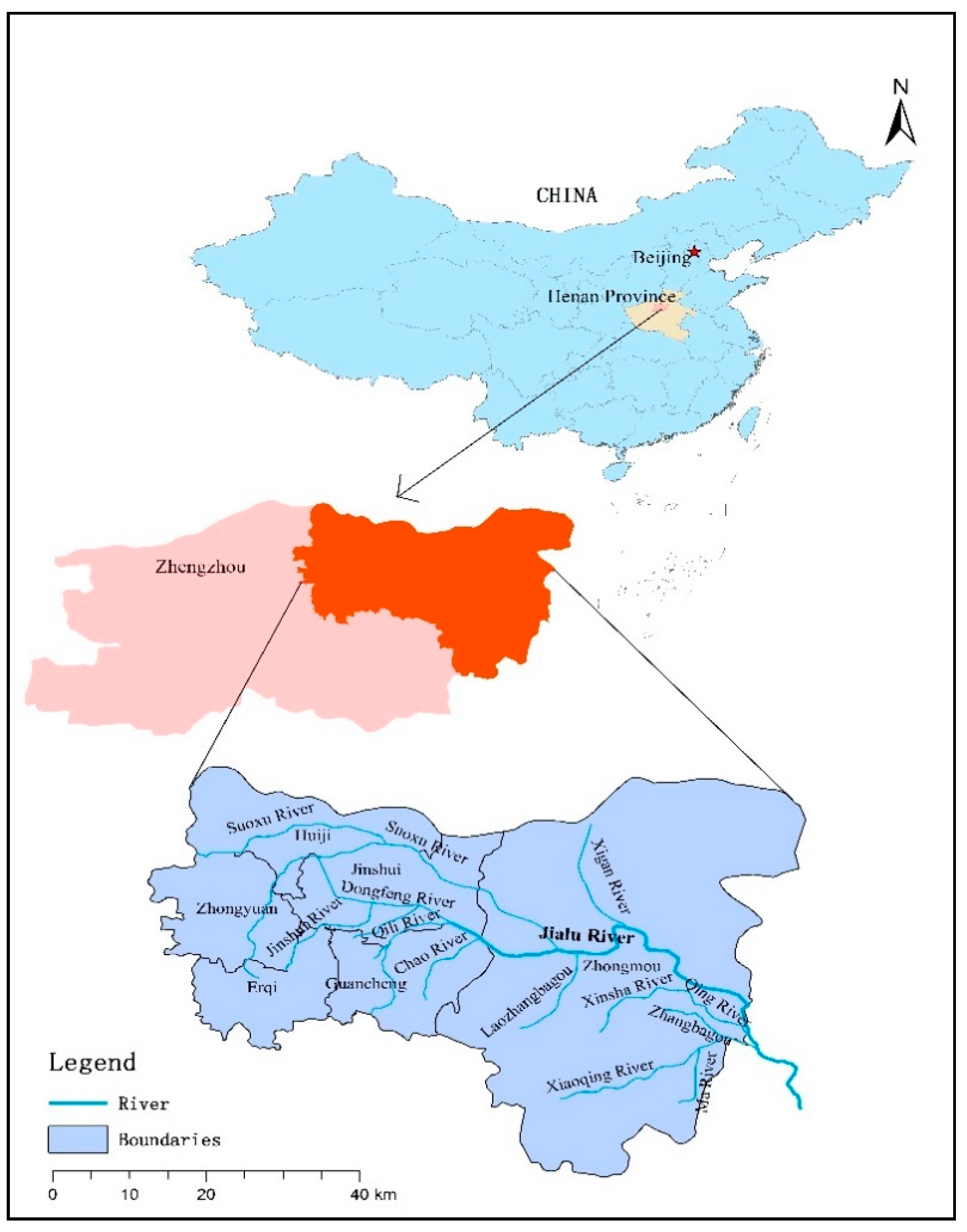


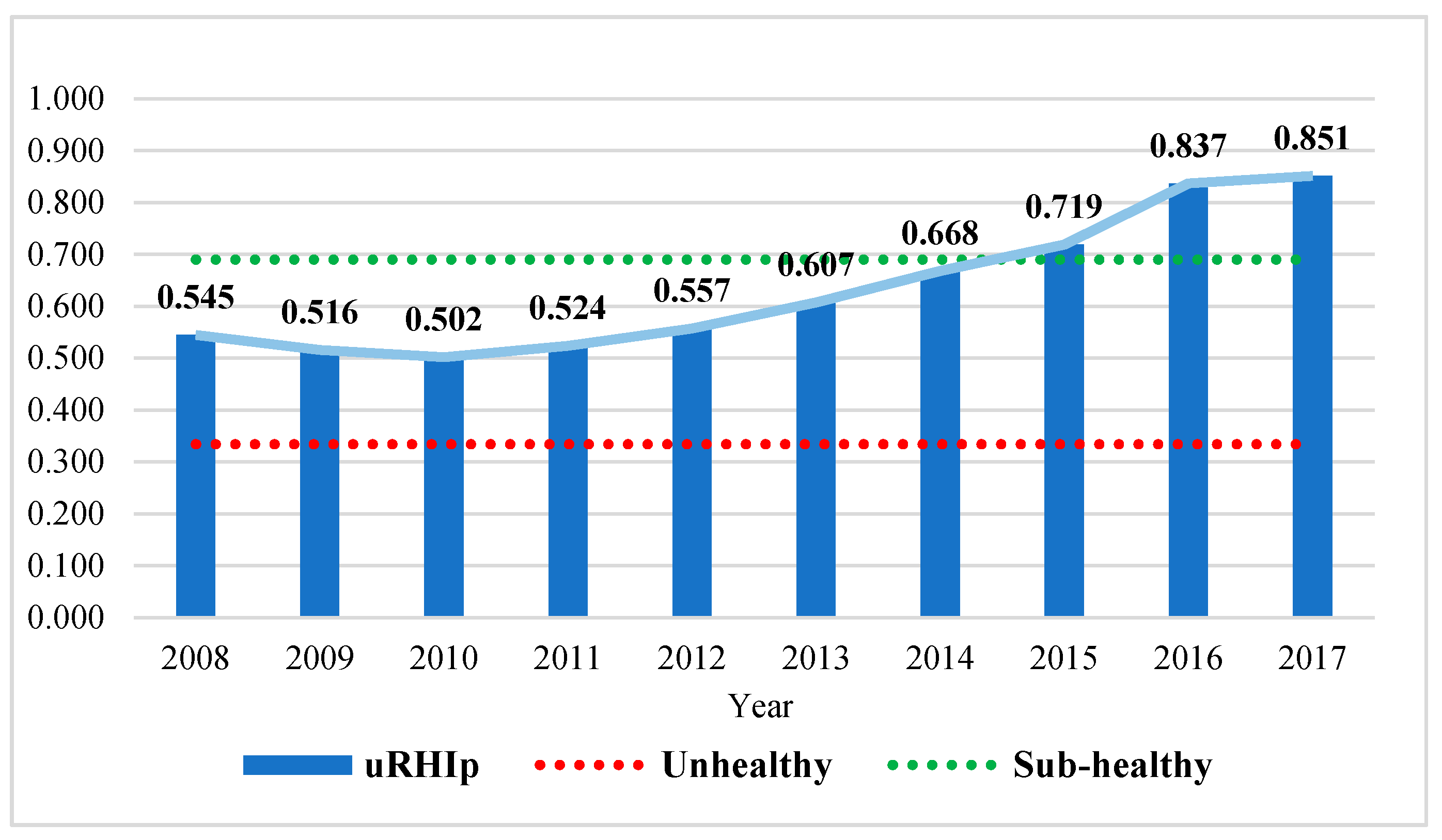


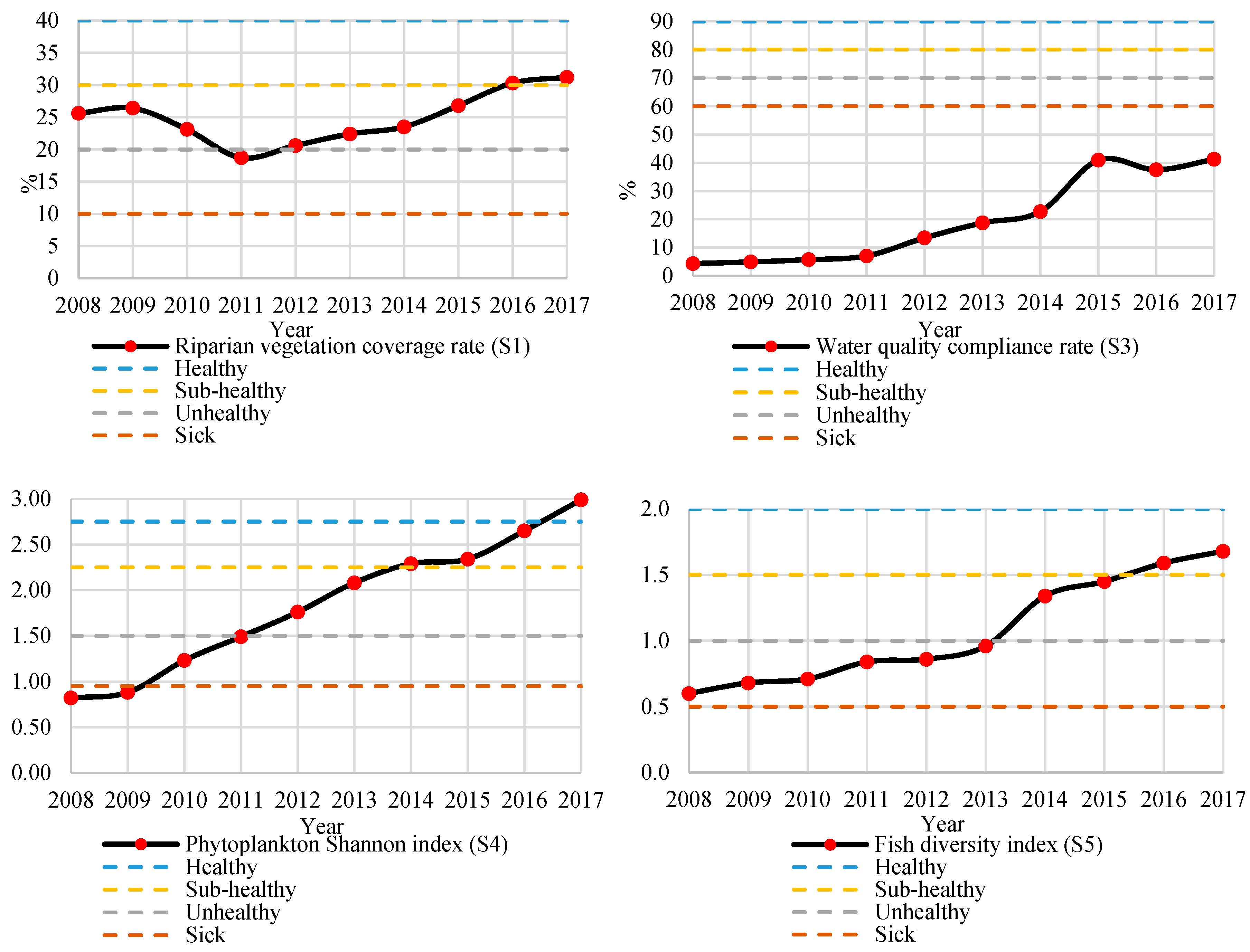
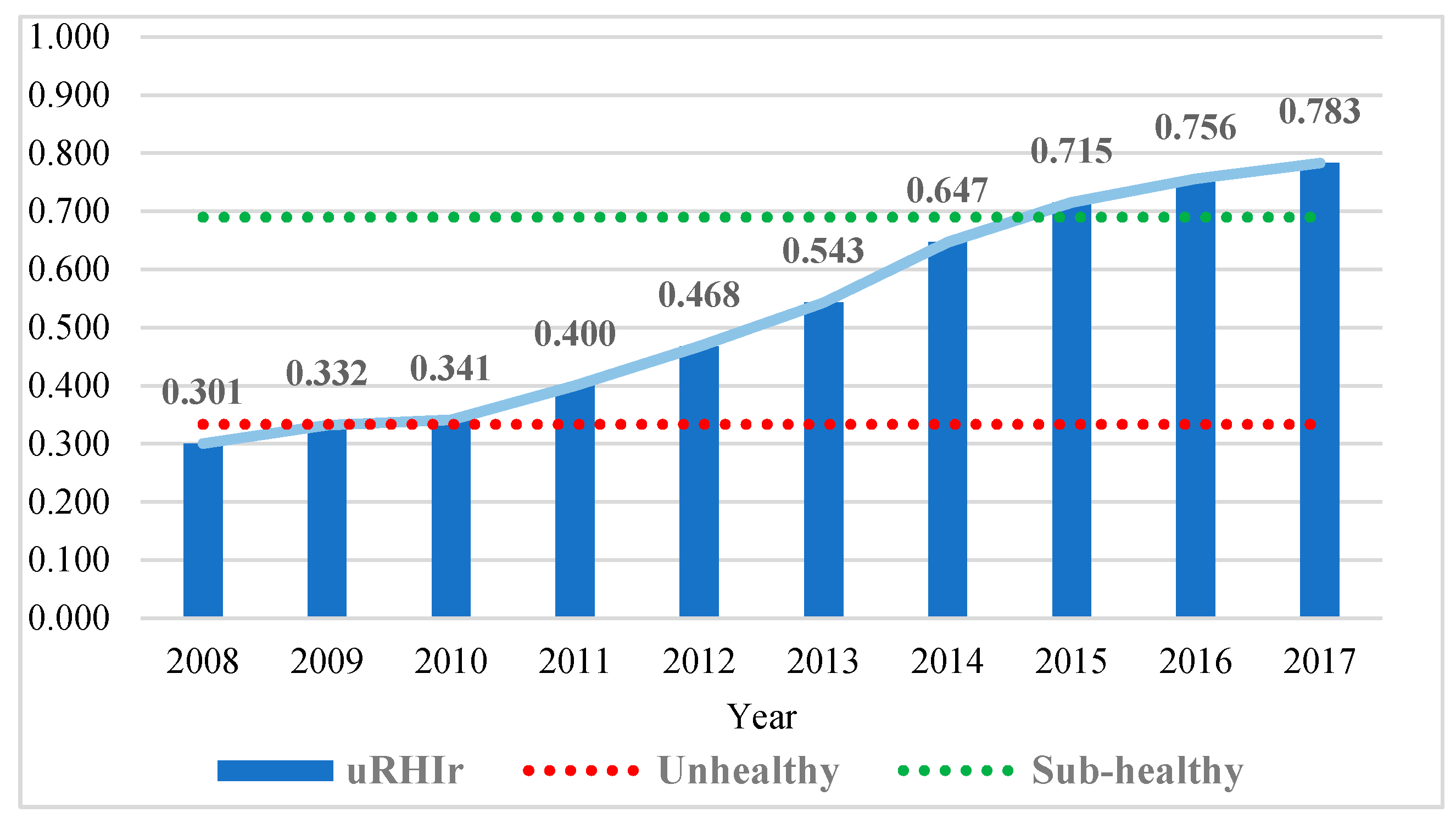
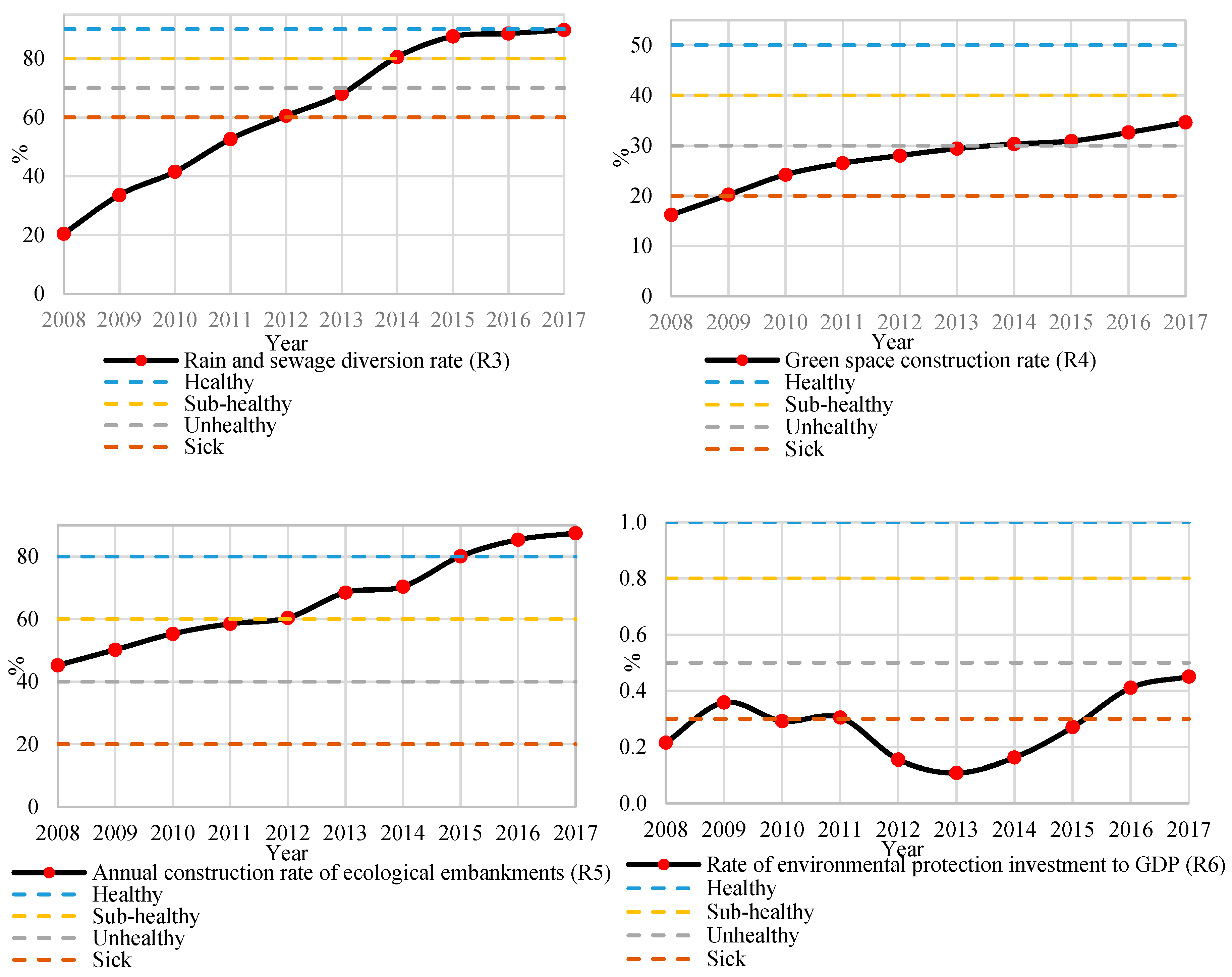
| Factor | Indicators | Unit | Description |
|---|---|---|---|
| Pressure | Ammonia emission intensity (P1) | t/a·km2 | Reflects the intensity of ammonia emissions on water quality |
| Pesticide application intensity (P2) | t/a·km2 | Reflects the intensity of pesticide application on water quality | |
| Fertilizer application intensity (P3) | t/a·km2 | Reflects the intensity of fertilizer application on water quality | |
| Water consumption per unit of GDP(P4) | m3/10−4 Yuan | Reflects the urban river pressure from economic development | |
| Water consumption of industrial output (P5) | m3/10−4 Yuan | Reflects the urban river pressure from industrial development | |
| Water consumption of agricultural output (P6) | m3/10−4 Yuan | Reflects the pressure of agricultural development on water resources | |
| COD emission (P7) | mg/L | Reflects the water environment pollution pressures on urban river | |
| Sewage discharge (P8) | 109 m3 | Reflects the intensity of sewage discharge on water quality | |
| State | Riparian vegetation coverage rate (S1) | % | Reflects the water quantity state of urban river water resources |
| Stability of riverbed (S2) | % | Reflects the stability of the urban river | |
| Water quality compliance rate (S3) | % | Reflects the water quality state of urban river water resources | |
| Phytoplankton Shannon index (S4) | / | Reflects the water quality state of urban river water resources | |
| Fish diversity index (S5) | / | Reflects the aquatic species state of urban river | |
| Longitudinal continuity (S6) | % | Reflects the stability of the urban river | |
| Response | Wastewater treatment rate (R1) | % | Reflects the response to water quality of urban river water resources |
| Daily ecological flow supplement rate (R2) | % | Reflects the response to water quantity of urban river water resources | |
| Rain and sewage diversion rate (R3) | % | Reflects the capacity of water resources management | |
| Green space construction rate (R4) | % | Reflects the capacity of water resources protection | |
| Annual construction rate of ecological embankments (R5) | % | Reflects the capacity of investment to aid in ecological management | |
| Rate of environmental protection investment to GDP (R6) | % | Reflects the capacity of investment to improve the environmental management and reduce the stress on the urban river |
| Factor | Indicators | Unit | Character | Healthy | Sub-Healthy | Unhealthy | Sick | Very Sick |
|---|---|---|---|---|---|---|---|---|
| Pressure | Ammonia emission intensity (P1) | t/a·km2 | − | ≤10 | (10, 14) | (14, 19) | (19, 24) | >24 |
| Pesticide application intensity (P2) | t/a·km2 | − | ≤0.5 | (0.5, 0.7) | (0.7, 1.0) | (1.0, 1.4) | >1.4 | |
| Fertilizer application intensity (P3) | t/a·km2 | − | ≤0.2 | (0.2, 0.4) | (0.4, 0.6) | (0.6, 0.8) | >0.8 | |
| Water consumption per unit of GDP (P4) | m3/10−4 Yuan | − | ≤100 | (100, 200) | (200, 300) | (300, 400) | >400 | |
| Water consumption of industrial output (P5) | m3/10−4 Yuan | − | ≤30 | (30, 60) | (60, 90) | (90, 120) | >120 | |
| Water consumption of agricultural output (P6) | m3/10−4 Yuan | − | ≤500 | (500, 1000) | (100, 1500) | (1500, 2000) | >2000 | |
| COD emission (P7) | mg/L | − | ≤15 | (15, 20) | (20, 30) | (30, 40) | >40 | |
| Sewage discharge (P8) | 109 m3 | − | ≤4 | (4, 6) | (6, 8) | (8, 10) | >10 | |
| State | Riparian vegetation coverage rate (S1) | % | + | ≥40 | (30, 40) | (20, 30) | (10, 20) | <10 |
| Stability of riverbed (S2) | % | + | ≥90 | (80, 90) | (70, 80) | (60, 70) | <60 | |
| Water quality compliance rate (S3) | % | + | ≥90 | (80, 90) | (70, 80) | (60, 70) | <60 | |
| Phytoplankton Shannon index (S4) | / | + | ≥2.75 | (2.25, 2.75) | (1.5, 2.25) | (0.95, 1.5) | <0.95 | |
| Fish diversity index (S5) | / | + | ≥2 | (2, 1.5) | (1.5, 1) | (0.5, 1) | <0.5 | |
| Longitudinal continuity (S6) | % | + | ≥90 | (80, 90) | (70, 80) | (60, 70) | <60 | |
| Response | Wastewater treatment rate (R1) | % | + | ≥80 | (60, 80) | (40, 60) | (20, 40) | <20 |
| Daily ecological flow supplement rate (R2) | % | + | ≥80 | (60, 80) | (40, 60) | (20, 40) | <20 | |
| Rain and sewage diversion rate (R3) | % | + | ≥90 | (80, 90) | (70, 80) | (60, 70) | <60 | |
| Green space construction rate (R4) | % | + | ≥50 | (40, 50) | (30, 40) | (20, 30) | <20 | |
| Annual construction rate of ecological embankments (R5) | % | + | ≥80 | (60, 80) | (40, 60) | (20, 40) | <20 | |
| Rate of environmental protection investment to GDP (R6) | % | + | ≥1 | (0.8, 1) | (0.5, 0.8) | (0.3, 0.5) | <0.3 |
| Factor | Indicators | Entropy Weight |
|---|---|---|
| Pressure (0.402) | P1 | 0.04992 |
| P2 | 0.05087 | |
| P3 | 0.04909 | |
| P4 | 0.04870 | |
| P5 | 0.05066 | |
| P6 | 0.05056 | |
| P7 | 0.0510 | |
| P8 | 0.05103 | |
| State (0.297) | S1 | 0.05104 |
| S2 | 0.04591 | |
| S3 | 0.05106 | |
| S4 | 0.04941 | |
| S5 | 0.04974 | |
| S6 | 0.04984 | |
| Response (0.301) | R1 | 0.05010 |
| R2 | 0.04936 | |
| R3 | 0.05102 | |
| R4 | 0.05063 | |
| R5 | 0.05061 | |
| R6 | 0.04930 |
| Health Grade | Healthy | Sub-Healthy | Unhealthy | Sick | Very Sick |
|---|---|---|---|---|---|
| 1 | (0.689, 1) | (0.334, 0.689) | (0, 0.334) | 0 |
| Year | Grade | ||||
|---|---|---|---|---|---|
| 2008 | 0.5445 | 0.2818 | 0.3009 | 0.3929 | Unhealthy |
| 2009 | 0.5161 | 0.3257 | 0.3325 | 0.4041 | Unhealthy |
| 2010 | 0.5021 | 0.3796 | 0.3411 | 0.4171 | Unhealthy |
| 2011 | 0.5237 | 0.3901 | 0.4002 | 0.4467 | Unhealthy |
| 2012 | 0.5574 | 0.4465 | 0.4681 | 0.4975 | Unhealthy |
| 2013 | 0.6074 | 0.5244 | 0.5430 | 0.5633 | Unhealthy |
| 2014 | 0.6683 | 0.6097 | 0.6469 | 0.6445 | Unhealthy |
| 2015 | 0.7192 | 0.6603 | 0.7154 | 0.7005 | Sub-healthy |
| 2016 | 0.8368 | 0.7303 | 0.7563 | 0.7808 | Sub-healthy |
| 2017 | 0.8513 | 0.7616 | 0.7833 | 0.8041 | Sub-healthy |
© 2019 by the authors. Licensee MDPI, Basel, Switzerland. This article is an open access article distributed under the terms and conditions of the Creative Commons Attribution (CC BY) license (http://creativecommons.org/licenses/by/4.0/).
Share and Cite
Zhang, K.; Shen, J.; Han, H.; Jia, Y. Urban River Health Analysis of the Jialu River in Zhengzhou City Using the Improved Fuzzy Matter-Element Extension Model. Water 2019, 11, 1190. https://doi.org/10.3390/w11061190
Zhang K, Shen J, Han H, Jia Y. Urban River Health Analysis of the Jialu River in Zhengzhou City Using the Improved Fuzzy Matter-Element Extension Model. Water. 2019; 11(6):1190. https://doi.org/10.3390/w11061190
Chicago/Turabian StyleZhang, Kaize, Juqin Shen, Han Han, and Yizhen Jia. 2019. "Urban River Health Analysis of the Jialu River in Zhengzhou City Using the Improved Fuzzy Matter-Element Extension Model" Water 11, no. 6: 1190. https://doi.org/10.3390/w11061190
APA StyleZhang, K., Shen, J., Han, H., & Jia, Y. (2019). Urban River Health Analysis of the Jialu River in Zhengzhou City Using the Improved Fuzzy Matter-Element Extension Model. Water, 11(6), 1190. https://doi.org/10.3390/w11061190





